SEO
Free SEO Plan Template (With Video Walkthrough)

Ranking in Google is the same (or at least very similar) for everyone. That’s why it’s essential to have an SEO plan template you can use time and time again.
So… we created one for you.
Looking for a different format? Request it here.
It gives you a proven SEO plan based on how we do things here at Ahrefs. And because it’s a template, it’s repeatable. Just go through it for every new page you create.
Our template is also:
- Easy to follow (each step has clear instructions).
- Easy to outsource (send it to an employee, freelancer, or VA).
- Interactive (fill in each section as you go).
Our template covers four broad areas:
- Finding the right keyword
- Creating and optimizing content
- Building links
- Tracking results
Follow the steps below or watch the video walkthrough.
1. Fill in keyword ideas
Keywords are the words and phrases people type into Google to find what they want. Unless you target a keyword with some popularity, there’s no point in even ranking number one as you’ll get no traffic.
To find keywords worth targeting, you need to do keyword research.
If you’re new to the process, start by entering a broad topic related to your industry into Ahrefs’ free keyword generator. It’ll find the top 100 keywords by monthly search volume that contain your term.
For example, if you have a website about coffee, you might enter “coffee”:
Pick five keywords from this list that might make sense for your business to target and record them in the template:
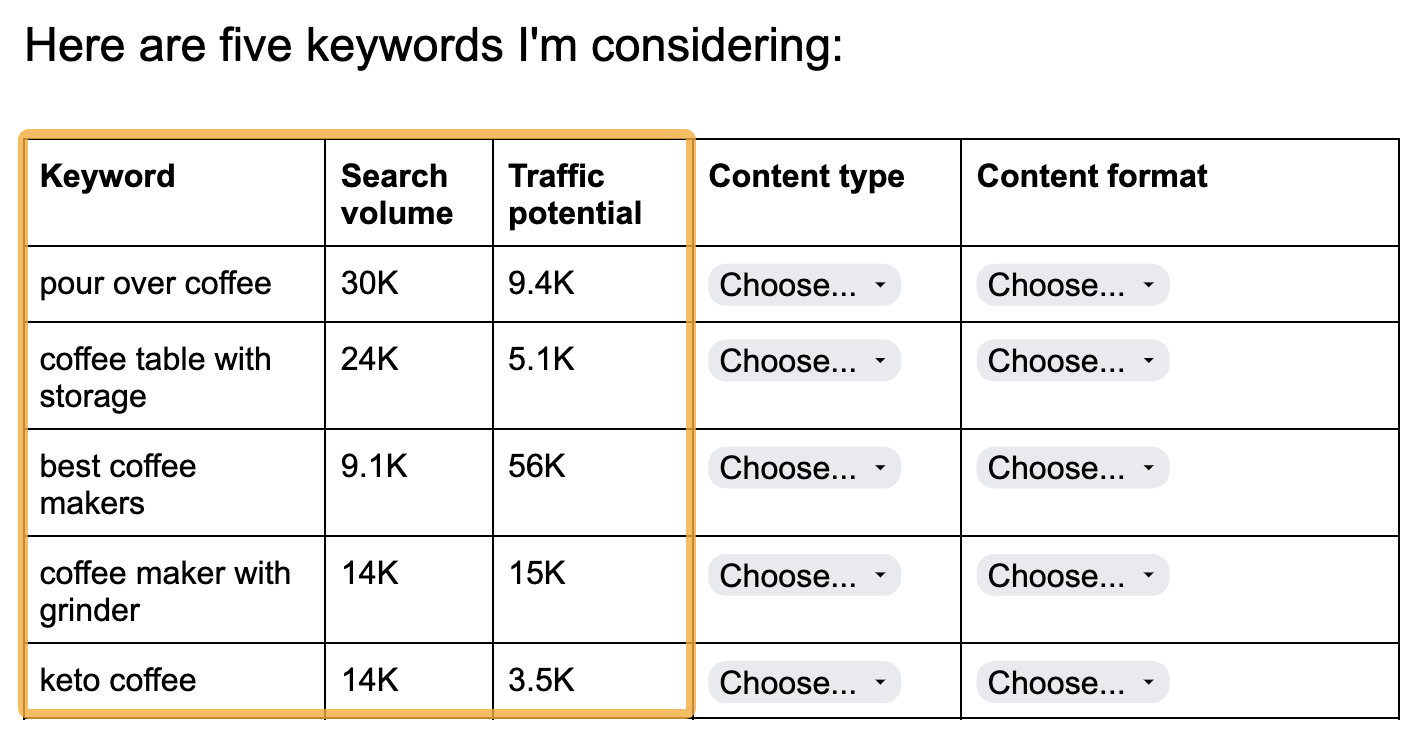

TIP: Keep the ‘business potential’ of your keyword choices in mind
“Business potential” is how easy it would be to pitch your product (or any third-party products you’re promoting) while covering a keyword. It’s important to consider because, for most websites, the purpose of ranking content in Google is to make money.
Here’s the scale we use to judge a keyword’s “business potential”:


2. Record search intent
Search intent is the reason behind the Google search. In other words, what is the searcher looking for? Unless you create content that aligns with search intent, you’re going to have a hard time ranking for your target keyword.
How do you know what searchers are looking for? Look at the current top 10 search results. The content types and formats you see here are usually a good indication of what people want.
Here are the most common content types:
- Blog post
- Video
- Product page
- Category page
Here are the most common content formats:
- How-to guides
- Step-by-step tutorials
- Reviews
- Comparisons
- Listicles
- Opinion pieces
For example, if we check the results for “best coffee makers” in the US with Ahrefs’ free SERP checker, nearly all of them are blog posts in the listicle format:
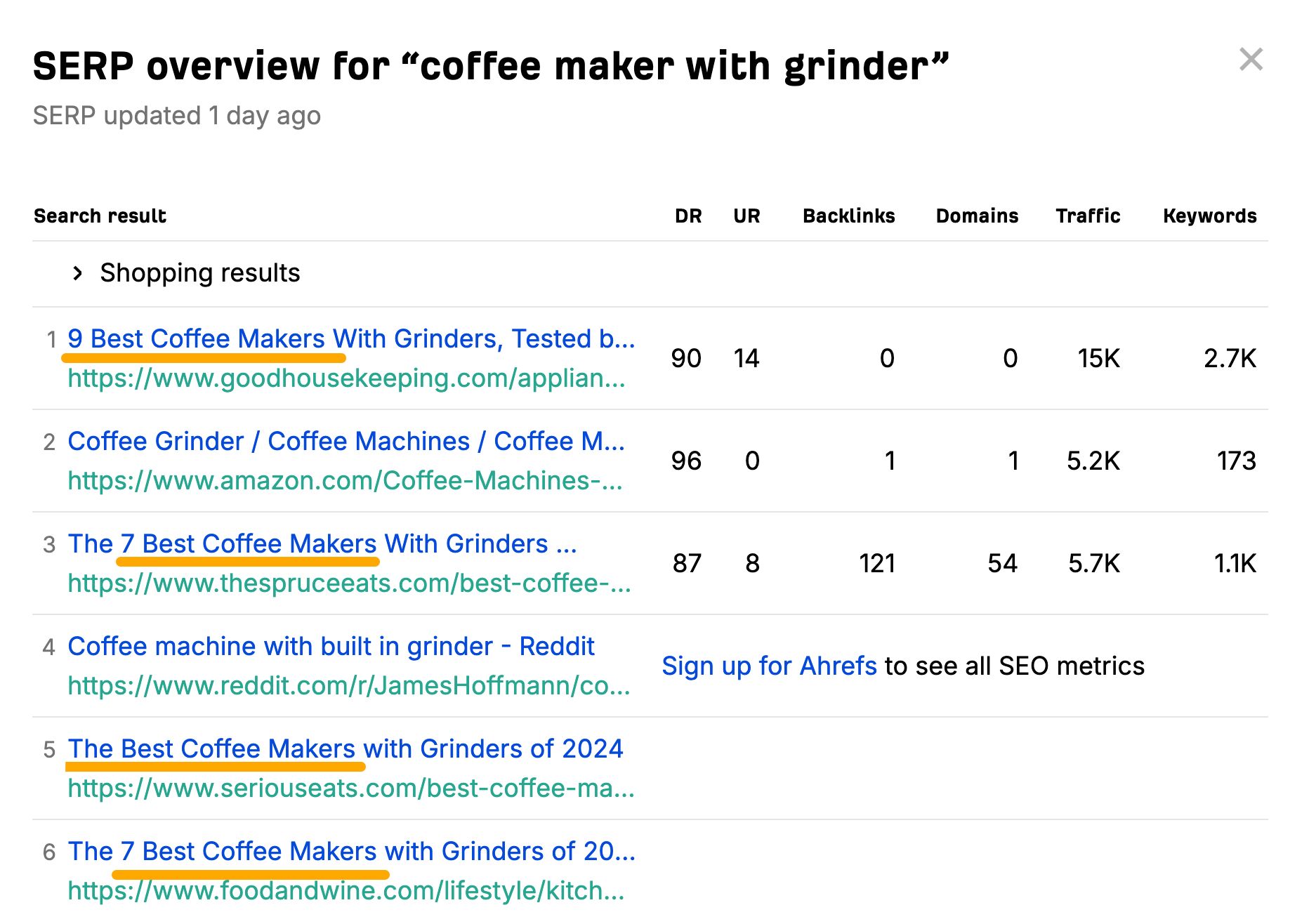

If we do the same thing for “coffee table with storage,” they’re all product category pages from ecommerce stores:


Record the results for all five keywords in the template. If you’re unsure about a keyword, choose “not sure”.


3. Pick the best keyword
For each of the five keywords on your list, ask yourself two questions:
- Can I create the type of content searchers are looking for?
- Would ranking that type of content be lucrative for my business?
Pick the keyword with the best balance of traffic and money-making potential and record it in the template.


If you’re struggling to answer the questions above, read the advice below.
Can I create the type of content searchers are looking for?
Let’s say that you run a coffee blog, and one of your keywords is “coffee table with storage.”
You’ll remember from above that all top-ranking results were product category pages from online stores. So, in this case, the answer to the question is “no” because you can’t create this type of content on a blog.
However, the answer would be “yes” for the keyword “coffee maker with grinder” because all the top-ranking results are listicle blog posts.
Would ranking that type of content be lucrative for my business?
Let’s run with the coffee blog example…
If the keyword is “coffee maker with grinder, ” the answer is “yes” because searchers want a listicle of the best products. You can monetize your product recommendations with affiliate marketing.
If the keyword is “how much caffeine in coffee,” the answer is “no” because it would be tough to recommend any product or service naturally in the content itself. People just want a quick answer.
4. Plan your content
It isn’t enough to create the type and format of content people are looking for. You also need to make sure that it covers key subtopics.
How do you know what these are? Look for commonalities among the top-ranking pages.
For example, if we check the subheadings for the first two top-ranking pages for “best coffee makers” with Ahrefs’ SEO Toolbar, we see that they both have sections on the best drip coffee makers and best pourover coffee makers:
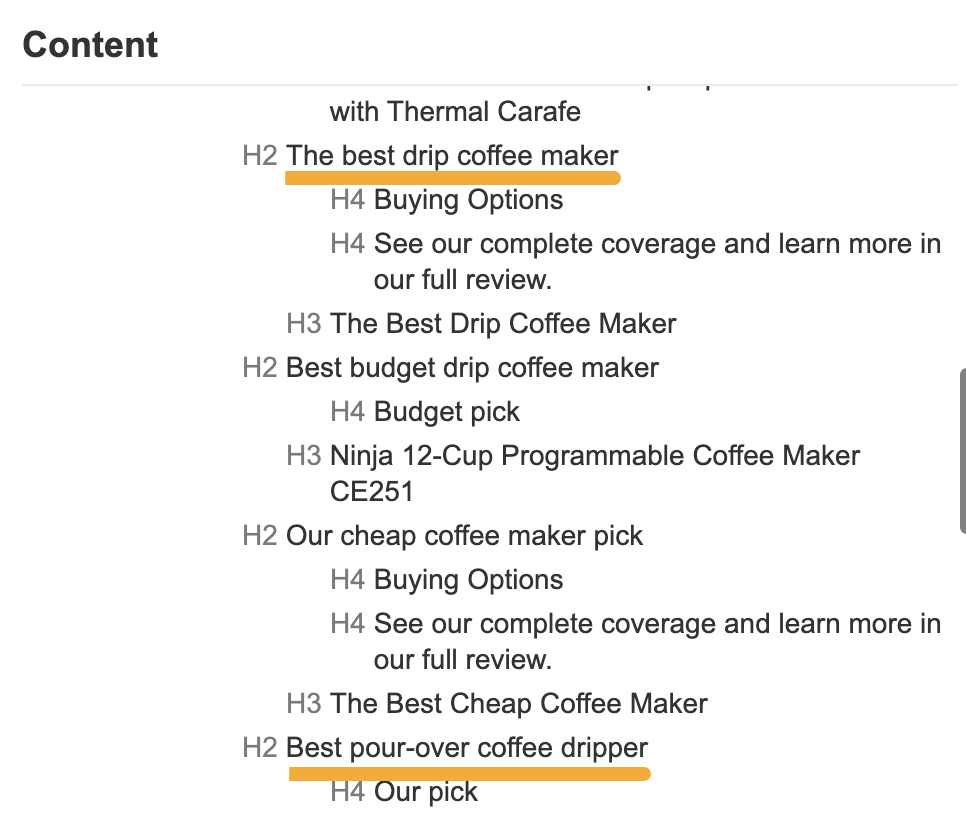



You would definitely want to talk about these three things if you were targeting the keyword “best coffee makers.”
If you’re an Ahrefs user, you can find key subtopics more easily using Keywords Explorer. Just enter your target keyword, go to the Related terms report, and toggle to view keywords that the top-ranking pages “also rank for” in the “top 10”:
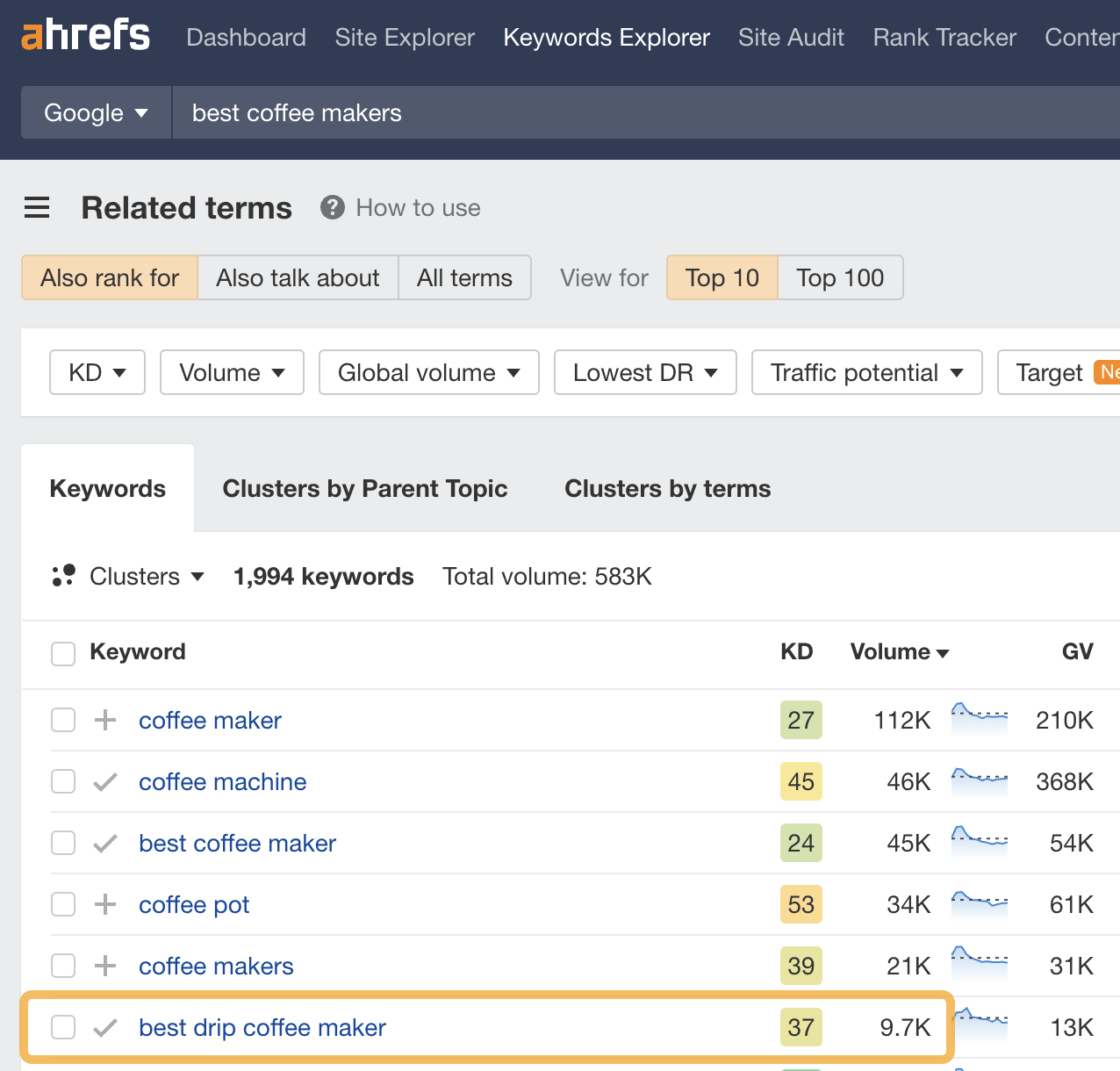

Look through this list for keywords that seem to represent subtopics, and record the top 5 in the template:


You also need to think about how you’ll make your content unique and demonstrate expertise.
There are a few ideas in the template. Tick any that you plan to use, or add your own:
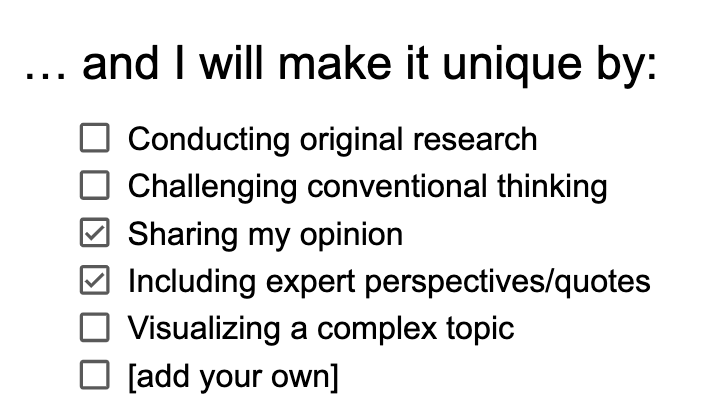

For example, in my guide to expert roundups, I covered all the subtopics searchers would expect to see, like what they are and why they’re important. But I also shared my opinion that expert roundups aren’t worth it, as well as the results of a couple of Twitter polls I did.
5. Publish and optimize your content
Most of the “optimization” happens during the content creation process. Still, there are a few things worth doing to ensure your content performs as well as it can.
Follow the checklist in the template:
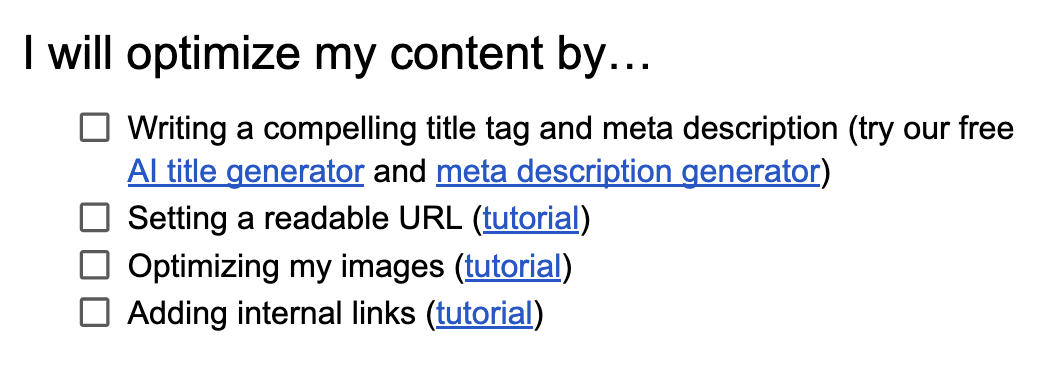

6. Plan link building efforts (if necessary)
Links are one of Google’s strongest ranking factors, so you’ll probably need to stand any chance at ranking high for any remotely competitive keyword.
Unfortunately, getting them can be very challenging.
If you’re completely new to the whole thing, the easiest starting point is to pitch guest posts to a few sites in your industry. This is far from the most trendy tactic, but it works (probably why it’s the third most popular link building tactic according to this 2022 survey).
Here’s a simple way to find sites to pitch with Ahrefs’ Content Explorer:
- Enter a broad keyword or phrase related to your niche
- Select “In title” from the drop-down menu
- Run the search
- Set your language to “English”
- Go to the “Websites” tab
You’ll see a list of the top 100 websites with content about your topic by estimated search traffic:


Eyeball this for blogs you might be able to pitch a guest post.
For example, coffeeaffection.com is clearly a blog and gets an estimated 426K monthly search visits:


For any sites you want to pitch, you’ll need to browse the site to find the right person to contact (usually the editor or owner, depending on the size of the site). If their email address isn’t on the site, you can use an email lookup tool like Hunter to try to find it.
Record the sites you want to pitch, who you’ll reach out to, and their email addresses in the template:


7. Track your results
Google Search Console is a free way of tracking how your page is performing for your target keyword. Just go to the Search Performance report, then filter for your URL and target keyword.
If you want to see actual ranking positions rather than averages (which most of us do), sign up for a free Ahrefs Webmaster Tools (AWT) account, then go to the Organic Keywords report in Site Explorer and filter for your target keyword. You should see its actual ranking position.
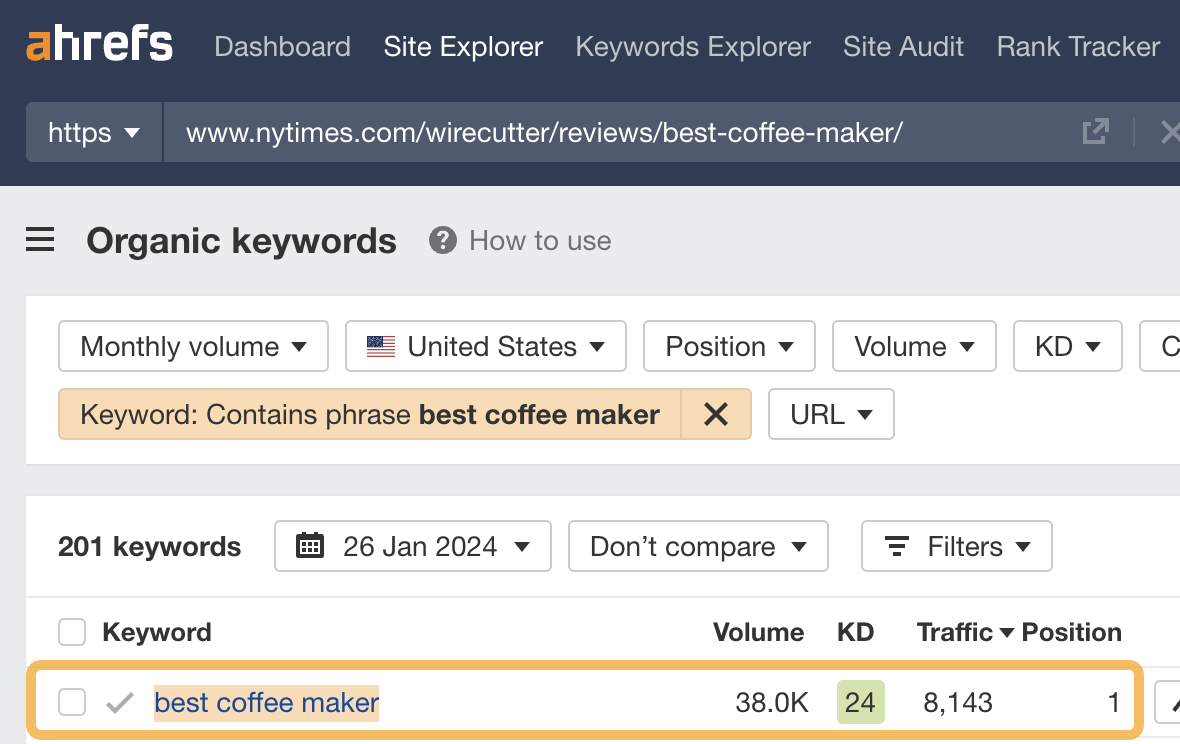

Either way, don’t get too obsessed over rankings. Daily fluctuations are perfectly normal, so weekly checks are more than enough.
Both of the tools above show past data, but if you want to record rankings for your records, you can do so in the template:
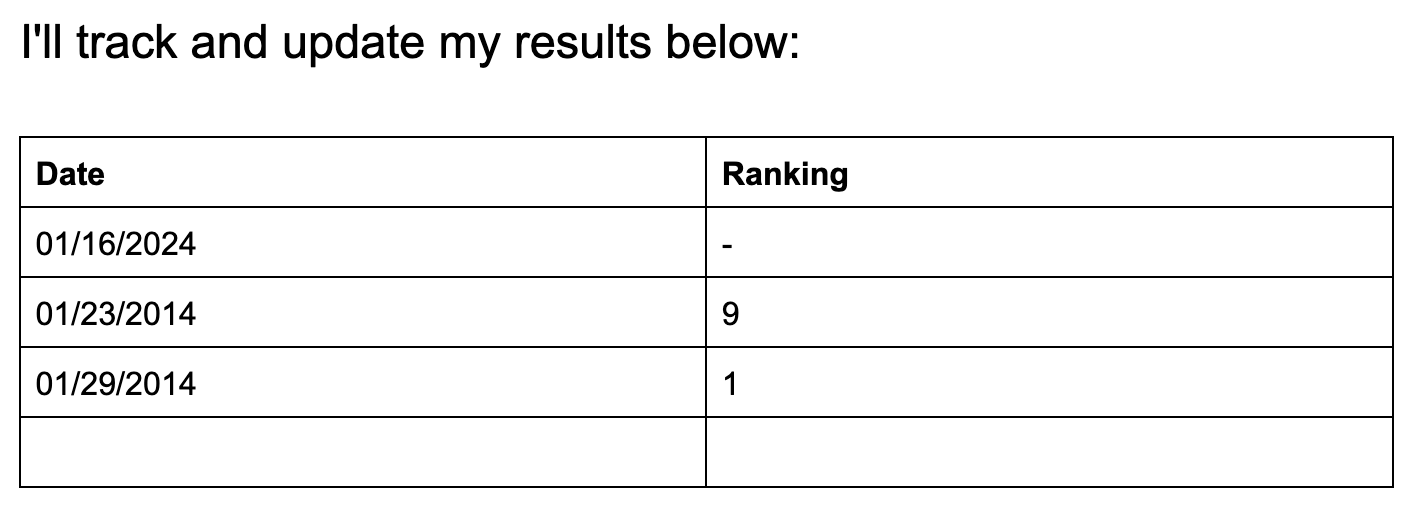

Ranking new pages is vital for SEO success, but it takes a lot of work. That’s why we also recommend running a content audit to find existing content that you may be able to improve rankings for easily. These are often low-hanging fruit opportunities that take little effort.
Alternatively, if you already have an existing page in mind that you want to improve SEO for, read our step-by-step guide to ranking higher on Google.
SEO
Google Cautions On Blocking GoogleOther Bot

Google’s Gary Illyes answered a question about the non-search features that the GoogleOther crawler supports, then added a caution about the consequences of blocking GoogleOther.
What Is GoogleOther?
GoogleOther is a generic crawler created by Google for the various purposes that fall outside of those of bots that specialize for Search, Ads, Video, Images, News, Desktop and Mobile. It can be used by internal teams at Google for research and development in relation to various products.
The official description of GoogleOther is:
“GoogleOther is the generic crawler that may be used by various product teams for fetching publicly accessible content from sites. For example, it may be used for one-off crawls for internal research and development.”
Something that may be surprising is that there are actually three kinds of GoogleOther crawlers.
Three Kinds Of GoogleOther Crawlers
- GoogleOther
Generic crawler for public URLs - GoogleOther-Image
Optimized to crawl public image URLs - GoogleOther-Video
Optimized to crawl public video URLs
All three GoogleOther crawlers can be used for research and development purposes. That’s just one purpose that Google publicly acknowledges that all three versions of GoogleOther could be used for.
What Non-Search Features Does GoogleOther Support?
Google doesn’t say what specific non-search features GoogleOther supports, probably because it doesn’t really “support” a specific feature. It exists for research and development crawling which could be in support of a new product or an improvement in a current product, it’s a highly open and generic purpose.
This is the question asked that Gary narrated:
“What non-search features does GoogleOther crawling support?”
Gary Illyes answered:
“This is a very topical question, and I think it is a very good question. Besides what’s in the public I don’t have more to share.
GoogleOther is the generic crawler that may be used by various product teams for fetching publicly accessible content from sites. For example, it may be used for one-off crawls for internal research and development.
Historically Googlebot was used for this, but that kind of makes things murky and less transparent, so we launched GoogleOther so you have better controls over what your site is crawled for.
That said GoogleOther is not tied to a single product, so opting out of GoogleOther crawling might affect a wide range of things across the Google universe; alas, not Search, search is only Googlebot.”
It Might Affect A Wide Range Of Things
Gary is clear that blocking GoogleOther wouldn’t have an affect on Google Search because Googlebot is the crawler used for indexing content. So if blocking any of the three versions of GoogleOther is something a site owner wants to do, then it should be okay to do that without a negative effect on search rankings.
But Gary also cautioned about the outcome that blocking GoogleOther, saying that it would have an effect on other products and services across Google. He didn’t state which other products it could affect nor did he elaborate on the pros or cons of blocking GoogleOther.
Pros And Cons Of Blocking GoogleOther
Whether or not to block GoogleOther doesn’t necessarily have a straightforward answer. There are several considerations to whether doing that makes sense.
Pros
Inclusion in research for a future Google product that’s related to search (maps, shopping, images, a new feature in search) could be useful. It might be helpful to have a site included in that kind of research because it might be used for testing something good for a site and be one of the few sites chosen to test a feature that could increase earnings for a site.
Another consideration is that blocking GoogleOther to save on server resources is not necessarily a valid reason because GoogleOther doesn’t seem to crawl so often that it makes a noticeable impact.
If blocking Google from using site content for AI is a concern then blocking GoogleOther will have no impact on that at all. GoogleOther has nothing to do with crawling for Google Gemini apps or Vertex AI, including any future products that will be used for training associated language models. The bot for that specific use case is Google-Extended.
Cons
On the other hand it might not be helpful to allow GoogleOther if it’s being used to test something related to fighting spam and there’s something the site has to hide.
It’s possible that a site owner might not want to participate if GoogleOther comes crawling for market research or for training machine learning models (for internal purposes) that are unrelated to public-facing products like Gemini and Vertex.
Allowing GoogleOther to crawl a site for unknown purposes is like giving Google a blank check to use your site data in any way they see fit outside of training public-facing LLMs or purposes related to named bots like GoogleBot.
Takeaway
Should you block GoogleOther? It’s a coin toss. There are possible potential benefits but in general there isn’t enough information to make an informed decision.
Listen to the Google SEO Office Hours podcast at the 1:30 minute mark:
Featured Image by Shutterstock/Cast Of Thousands
SEO
AI Search Boosts User Satisfaction

A new study finds that despite concerns about AI in online services, users are more satisfied with search engines and social media platforms than before.
The American Customer Satisfaction Index (ACSI) conducted its annual survey of search and social media users, finding that satisfaction has either held steady or improved.
This comes at a time when major tech companies are heavily investing in AI to enhance their services.
Search Engine Satisfaction Holds Strong
Google, Bing, and other search engines have rapidly integrated AI features into their platforms over the past year. While critics have raised concerns about potential negative impacts, the ACSI study suggests users are responding positively.
Google maintains its position as the most satisfying search engine with an ACSI score of 81, up 1% from last year. Users particularly appreciate its AI-powered features.
Interestingly, Bing and Yahoo! have seen notable improvements in user satisfaction, notching 3% gains to reach scores of 77 and 76, respectively. These are their highest ACSI scores in over a decade, likely due to their AI enhancements launched in 2023.
The study hints at the potential of new AI-enabled search functionality to drive further improvements in the customer experience. Bing has seen its market share improve by small but notable margins, rising from 6.35% in the first quarter of 2023 to 7.87% in Q1 2024.
Customer Experience Improvements
The ACSI study shows improvements across nearly all benchmarks of the customer experience for search engines. Notable areas of improvement include:
- Ease of navigation
- Ease of using the site on different devices
- Loading speed performance and reliability
- Variety of services and information
- Freshness of content
These improvements suggest that AI enhancements positively impact various aspects of the search experience.
Social Media Sees Modest Gains
For the third year in a row, user satisfaction with social media platforms is on the rise, increasing 1% to an ACSI score of 74.
TikTok has emerged as the new industry leader among major sites, edging past YouTube with a score of 78. This underscores the platform’s effective use of AI-driven content recommendations.
Meta’s Facebook and Instagram have also seen significant improvements in user satisfaction, showing 3-point gains. While Facebook remains near the bottom of the industry at 69, Instagram’s score of 76 puts it within striking distance of the leaders.
Challenges Remain
Despite improvements, the study highlights ongoing privacy and advertising challenges for search engines and social media platforms. Privacy ratings for search engines remain relatively low but steady at 79, while social media platforms score even lower at 73.
Advertising experiences emerge as a key differentiator between higher- and lower-satisfaction brands, particularly in social media. New ACSI benchmarks reveal user concerns about advertising content’s trustworthiness and personal relevance.
Why This Matters For SEO Professionals
This study provides an independent perspective on how users are responding to the AI push in online services. For SEO professionals, these findings suggest that:
- AI-enhanced search features resonate with users, potentially changing search behavior and expectations.
- The improving satisfaction with alternative search engines like Bing may lead to a more diverse search landscape.
- The continued importance of factors like content freshness and site performance in user satisfaction aligns with long-standing SEO best practices.
As AI becomes more integrated into our online experiences, SEO strategies may need to adapt to changing user preferences.
Featured Image: kate3155/Shutterstock
SEO
Google To Upgrade All Retailers To New Merchant Center By September

Google has announced plans to transition all retailers to its updated Merchant Center platform by September.
This move will affect e-commerce businesses globally and comes ahead of the holiday shopping season.
The Merchant Center is a tool for online retailers to manage how their products appear across Google’s shopping services.
Key Changes & Features
The new Merchant Center includes several significant updates.
Product Studio
An AI-powered tool for content creation. Google reports that 80% of current users view it as improving efficiency.
This feature allows retailers to generate tailored product assets, animate still images, and modify existing product images to match brand aesthetics.
It also simplifies tasks like background removal and image resolution enhancement.
Centralized Analytics
A new tab consolidating various business insights, including pricing data and competitive analysis tools.
Retailers can access pricing recommendations, competitive visibility reports, and retail-specific search trends, enabling them to make data-driven decisions and capitalize on popular product categories.
Redesigned Navigation
Google claims the new interface is more intuitive and cites increased setup success rates for new merchants.
The platform now offers simplified website verification processes and can pre-populate product information during setup.
Initial User Response
According to Google, early adopters have shown increased engagement with the platform.
The company reports a 25% increase in omnichannel merchants adding product offers in the new system. However, these figures have yet to be independently verified.
Jeff Harrell, Google’s Senior Director of Merchant Shopping, states in an announcement:
“We’ve seen a significant increase in retention and engagement among existing online merchants who have moved to the new Merchant Center.”
Potential Challenges and Support
While Google emphasizes the upgrade’s benefits, some retailers, particularly those comfortable with the current version, may face challenges adapting to the new system.
The upgrade’s mandatory nature could raise concerns among users who prefer the existing interface or have integrated workflows based on the current system.
To address these concerns, Google has stated that it will provide resources and support to help with the transition. This includes tutorial videos, detailed documentation, and access to customer support teams for troubleshooting.
Industry Context
This update comes as e-commerce platforms evolve, with major players like Amazon and Shopify enhancing their seller tools. Google’s move is part of broader efforts to maintain competitiveness in the e-commerce services sector.
The upgrade could impact consumers by improving product listings and providing more accurate information across Google’s shopping services.
For the e-commerce industry as a whole, it signals a continued push towards AI-driven tools and data-centric decision-making.
Transition Timeline
Google states that retailers will be automatically upgraded by September if they still need to transition.
The company advises users to familiarize themselves with the new features before the busy holiday shopping period.
Featured Image: BestForBest/Shutterstock
-

 SEARCHENGINES6 days ago
SEARCHENGINES6 days agoBillions Of Google goo.gl URLs To 404 In The Future
-
SEARCHENGINES5 days ago
Daily Search Forum Recap: July 22, 2024
-

 SEARCHENGINES7 days ago
SEARCHENGINES7 days agoGoogle Core Update Coming, Ranking Volatility, Bye Search Notes, AI Overviews, Ads & More
-

 SEO6 days ago
SEO6 days ago11 Copyscape Alternatives To Check Plagiarism
-

 SEO6 days ago
SEO6 days agoGoogle Warns Of Last Chance To Export Notes Search Data
-
SEARCHENGINES4 days ago
Daily Search Forum Recap: July 23, 2024
-

 AFFILIATE MARKETING6 days ago
AFFILIATE MARKETING6 days agoThe Top 5 AI Tools That Can Revolutionize Your Workflow and Boost Productivity
-

 SEO4 days ago
SEO4 days agoSystem Builders – How AI Changes The Work Of SEO















